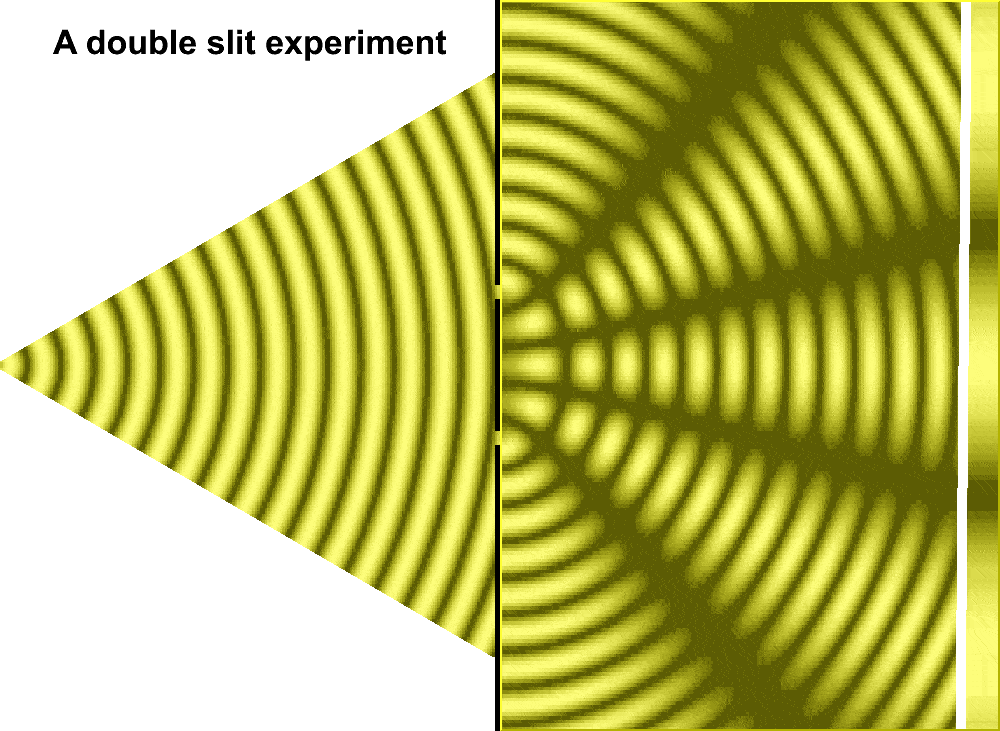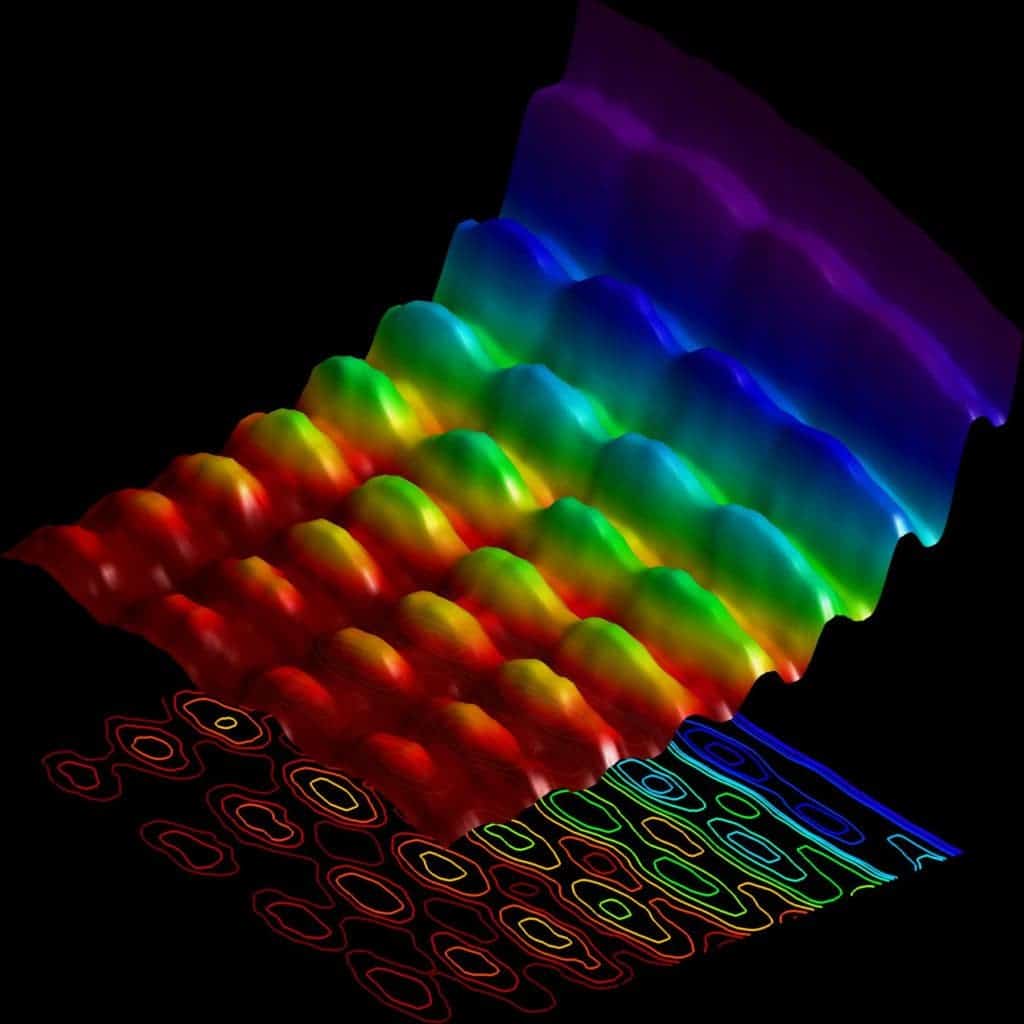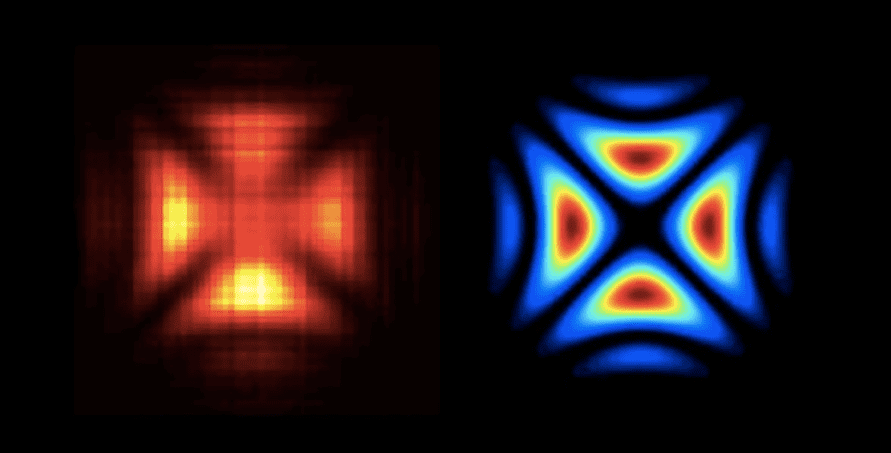The Word "Photon" Can Be Used to Describe
Imagine a shaft of xanthous sunlight effulgent through a window. According to breakthrough physics that axle is fabricated of zillions of tiny packets of lite, called photons, streaming through the air. Simply what exactly is a photon?

Definition
A photon is the smallest discrete amount or quantum of electromagnetic radiation. It is the basic unit of all light.
Photons are always in motion and, in a vacuum, travel at a abiding speed to all observers of 2.998 10 108 m/s. This is commonly referred to as the speed of light, denoted by the letterc.
As per Einstein's light quantum theory, photons have energy equal to their oscillation frequency times Planck's abiding. Einstein proved that light is a menstruum of photons, the energy of these photons is the acme of their oscillation frequency, and the intensity of the light corresponds to the number of photons. Essentially, he explained how a stream of photons can act both every bit a wave and particle.
Photon backdrop
The bones properties of photons are:
- They have naught mass and rest energy. They merely be every bit moving particles.
- They are elementary particles despite defective remainder mass.
- They accept no electric charge.
- They are stable.
- They are spin-1 particles which makes them bosons.
- They comport energy and momentum which are dependent on the frequency.
- They can have interactions with other particles such as electrons, such equally the Compton outcome.
- They tin can exist destroyed or created by many natural processes, for instance when radiation is absorbed or emitted.
- When in empty space, they travel at the speed of light.
History
The nature of calorie-free — whether you regard it as a particle or a wave — was 1 of the greatest scientific debates. For centuries philosophers and scientists have argued about the thing that was barely resolved a century ago.
The disciples of a 6th century BC branch of Hindu philosophy called Vaisheshika had a surprising physical intuition about light. Like the ancient Greeks, they used to believe the earth was based on 'atoms' of earth, air, fire, and h2o. Lite itself was idea to be fabricated of such very fast-moving atoms calledtejas.That'due south remarkably similar to our modern theory of light and its composing photons, a term coined thousands of years later in 1926 by a pharmacist named Gilbert Lewis and an optical physicist called Frithiof Wolfers.
Afterward, around 300 BC, the ancient Greek physicist Euclid made a huge breakthrough when he posited light traveled in directly lines. Euclid also described the laws of reflection and, a century later on, Ptolemy complemented with writings well-nigh refraction. IT wasn't until 1021, however, that the laws of refraction were formally established in the seminal workKitab al-Manazir, or Volume of Optics, by Ibn al-Haytham.
The Renaissance would usher in a new age of scientific inquiry into the nature of light. Of note are René Descartes' incursions in a 1637 essay calledLa dioptrique,where he argued that light is made of pulses that propagate instantaneously when contacting 'assurance' in a medium. Subsequently writing inTraité de la lumièrepublished in 1690, Christiaan Huygens treated light as compressible waves in an rubberband medium, but similar sound pressure waves. Huygens showed how to make reflected, refracted, and screened waves of light and besides explained double refraction.
By this time, scientists had divide into two entrenched camps. One side believed that lite was a moving ridge while the other view was of light as particles or corpuscles. The great champion of the so-called 'corpuscularists' was none other than Isaac Newton, widely believed as the greatest scientist e'er. Newton wasn't fond at all of the wave theory since that would mean lite would exist able to stray as well far into the shadow.
For much of the 18th century, corpuscular theory dominated the argue around the nature of calorie-free. But and then, in May 1801, Thomas Immature introduced the world to his now famous two-slit experiment where he demonstrated the interference of light waves.

In the first version of the experiment, Young actually didn't use two slits, but rather a single thin carte. The physicist only covered a window with a piece of newspaper with a tiny hole in it which served to funnel a sparse beam of low-cal. With the card in his paw, Young witnessed how the beam carve up in two. Light passing on one side of the bill of fare interfered with light from the other side of the card to create fringes, which could be observed on the opposite wall. Later, Young used this data to calculate the wavelengths of diverse colors of lite and came remarkably close to modern values. The demonstration would provide solid evidence that light was a wave, not a particle.
Meanwhile, this time in France, the corpuscularist move was gaining steam after recent developments attributed the polarization of light to some kind of asymmetry among the lite corpuscles. They suffered a great defeat at the manus of Augustin Fresnel who in 1821 showed that polarization could be explained if lite were a transverse moving ridge with no longitudinal vibration. Previously, Fresnel likewise came up with a precise wave theory of diffraction.
By this point, there was little stable ground for Newton's followers to go along the debate. Information technology seemed light is a wave and that's that. The problem was that the fabled aether — the mysterious medium required to support electromagnetic fields and to yield Fresnel'south laws of propagation — was missing despite everyone's all-time efforts to find it. No 1 ever did, actually.
A huge quantum came in 1861 when James Clerk Maxwell condensed experimental and theoretical knowledge about electricity and magnetism in twenty equations. Maxwell predicted an 'electromagnetic moving ridge', which can self-sustain, even in a vacuum, in the absence of conventional currents. This means no aether is required for light to propagate! Moreover, he predicted the speed of this wave to be 310,740,000 chiliad s−1 — that'due south just a few percent of the exact value of the speed of light.
"The agreement of the results seems to show that calorie-free and magnetism are affections of the same substance, and lite is an electromagnetic disturbance propagated through the field co-ordinate to electromagnetic laws", wrote Maxwell in 1865.
From that day forward, the concept of light was united with those of electricity and magnetism for the start time.
On 14 December 1900, Max Planck demonstrated that heat radiation was emitted and captivated in discrete packets of energy — quanta. Later on, Albert Einstein showed in 1905 that this besides applied to light. Einstein used the term Lichtquant, or quantum of calorie-free. Now, at the dawn of the 20th-century, a new revolution in physics would once again hinge on the nature of light. This time, information technology's not virtually whether light is a crepuscule or wave. It's whether it's both or not.
Modern theory of light and photons
Einstein believed calorie-free is a particle (photon) and the flow of photons is a wave. The German language physicist was convinced light had a particle nature following his discovery of the photoelectric issue, in which electrons wing out of a metal surface exposed to light. If light was a wave, that couldn't have happened. Another puzzling matter is how photoelectrons multiply when stiff light is applied. Einstein explained the photoelectric effect by saying that "light itself is a particle," for which he would later receive the Nobel Prize in Physics.
The main point of Einstein's lite breakthrough theory is that calorie-free's energy is related to its oscillation frequency. He maintained that photons accept energy equal to "Planck'south constant times oscillation frequency," and this photon energy is the height of the oscillation frequency while the intensity of low-cal corresponds to the number of photons. The various backdrop of light, which is a blazon of electromagnetic moving ridge, are due to the behavior of extremely minor particles called photons that are invisible to the naked middle.
Einstein speculated that when electrons within matter collide with photons, the erstwhile takes the latter's free energy and flies out and that the college the oscillation frequency of the photons that strike, the greater the electron energy that will come flight out. Some of you take a working proof of this idea in your very own dwelling — information technology's the solar panels! In short, he was proverb that light is a flow of photons, the free energy of these photons is the height of their oscillation frequency, and the intensity of the light is related to the number of photons.
Einstein was able to prove his theory by deriving Planck's constant from his experiments on the photoelectric outcome. His calculations rendered a Planck's abiding value of6.6260755 x ten-34 which is exactly what Max Planck obtained in 1900 through his research on electromagnetic waves. Unequivocally, this pointed to an intimate relationship between the properties and the oscillation frequency of light every bit a moving ridge and the properties and momentum of light as a particle. Later, during the 1920s, Austrian physicist Erwin Schrödinger elaborated on these ideas with his equation for the breakthrough wave office to describe what a moving ridge looks like.
More than a hundred years since Einstein showed the double nature of light, Swiss physicists at the École Polytechnique Fédérale de Lausanne captured the first-e'er snapshot of this dual behavior. The squad led past Fabrizio Carbone performed a clever experiment in 2022 in which a laser was used to fire onto a nanowire, causing electrons to vibrate. Calorie-free travels forth this tiny wire in ii possible directions, like cars on a highway. When waves traveling in opposite directions encounter each other they form a new wave that looks like it is standing in place. Here, this standing wave becomes the source of light for the experiment, radiating around the nanowire. The fired a new axle of electrons to image the standing moving ridge of low-cal, which acts equally a fingerprint of the moving ridge-nature of light. The event can be seen below.

What a photon looks like
Have y'all ever wondered what shape does a photon have? Scientists have been pondering this question for decades and, finally, in 2016, Polish physicists created the first ever hologram of a single lite particle. The team at the University of Warsaw made the hologram past firing ii low-cal beams at a beamsplitter, made of calcite crystal, at the same fourth dimension. The beamsplitter is akin to a traffic low-cal intersection so each photon tin either laissez passer directly through or make a turn. When a photon is on its own, each path is as probable simply when more photons are involved they interact and the odds alter. If yous know the moving ridge function of one of the photons, it's possible to figure out the shape of the second from the positions of flashes appearing on a detector. The resulting image looks a bit like a Maltese cross, merely like the wave part predicted from Schrödinger's equation.

Facts about photons
- Not only is light made up of photons, merely all electromagnetic energy (i.e. microwaves, radio waves, X-rays) is fabricated up of photons.
- The original concept of the photon was developed by Albert Einstein. However, information technology was scientist Gilbert N. Lewis who outset used the give-and-take "photon" to describe it.
- The theory that states that lite behaves both like a wave and a particle is chosen the wave-particle duality theory.
- Photons are always electrically neutral. They have no electrical charge.
- Photons do non decay on their own.
Source: https://www.zmescience.com/science/what-is-photon-definition-04322/
0 Response to "The Word "Photon" Can Be Used to Describe"
Post a Comment